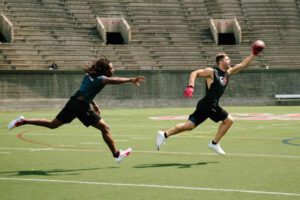Athletes tend to do a good job of training their muscles, heart and lungs. But some of them (particularly endurance athletes and those in running sports) commonly fail to train their gut. As one marathoner reported, “I was so afraid of getting diarrhea during long training runs that I did not eat or drink anything beforehand. I really struggled after 14 miles…” A high school soccer player admitted, “I’m so afraid I’ll throw up if I run with food in my stomach.” He ate only a light lunch at 11:00 and then practiced on fumes at 3:30. No wonder he had a disappointing season.
An estimated 30-50% of endurance athletes (including up to 90% of distance runners) have experienced gastro-intestinal (GI) issues during and after hard exercise.
They fear bloat, gas, nausea, stomach cramps/pain, side stitch, diarrhea, vomiting, and urge to defecate. These issues arise during long bouts of exercise because blood flow to the gut is reduced for an extended period of time. When combined with dehydration, elevated body temperature and high levels of stress hormones, normal intestinal function can abruptly end.
If you are an athlete with a finicky GI tract, restricting your diet before and during exercise will not solve the problem. You want to learn how to train your gut to accommodate performance enhancing carbs and water. That way, you can train better—hence compete better—without stressing about undesired pit stops.
Thankfully, the gut is trainable. Competitive eaters have proven this point. Google Nathans’ Hot Dog Eating Competition and watch the video of a champ who stuffed 72 hotdogs into his stomach in 10 minutes. Clearly, he had to train his gut to be able to complete that task.
Competitive eating is unlikely your goal, but you may want to be competitive in your sport. That means you need to fuel wisely in order to perform optimally. While some “keto-athletes” choose to train their bodies to rely on fat for fuel (fat is less likely to cause GI distress), training the gut is a far easier alternative for most of us.
The following tips can help you exercise with digestive peace:
- Drink enough fluids. Dehydration triggers intestinal problems. Your goal is to drink enough to prevent 2% dehydration (sweat loss of 2 pounds per 100 pounds of body weight from pre- to post-exercise). If you are a “big guy” who sweats heavily, this can be a lot of fluid. For example, a 200-pound football player could easily lose 4 pounds (a half-gallon) of sweat in an hour of exercise. He needs to train his gut to handle fluid replacement during training. He could need as much as 12 to 16 ounces every 15 minutes during a two-hour practice.
- Feeling “full” and “bloated” during exercise indicates fluids (and foods) have not emptied from the stomach. This commonly happens during really hard exercise, when reduced blood flow to the stomach delays stomach emptying. Hot weather and prolonged exercise in the heat can also reduce stomach emptying.
- You want to dilute highly concentrated carbs (i.e., gels), so be sure to drink enough water during exercise (i.e. 16 oz. water per 100 calories gel).This will help speed up gastric emptying.
- If you plan to eat a peanut butter on a bagel before you compete, you want to routinely eat that before important training sessions. This helps train your gut to accommodate fat (sustained energy) as well as carbs (quick energy).
- Once carbohydrate (such as sport drink, gel, banana, or gummy bears) empties from the stomach, it enters the small intestine and is broken down into one of three simple sugars (glucose, fructose, galactose). These sugars need “taxi cabs” to get transported out of the intestine and into the blood stream.
- Too many gels or chomps without enough transporters can lead to diarrhea. By training with your race-day carbs, you can increase the number of transporters.
- If you typically eat a low-carb Paleo or keto-type diet and then on the day of, let’s say, a marathon, you decide to fuel with carb-rich gels and sports drinks, your body won’t have the capacity to optimally transport the sugar (carbs) out of your intestines and to your muscles. You could easily end up with diarrhea.
- When planning what to eat during extended exercise, choose from a variety of carbs with a variety of sugars (i.e., sport drink, gum drops, and maple sugar candy). This helps prevent the glucose transporters from getting saturated. Too much of one kind of sport food can easily create GI problems.
- “Real foods” such as banana, raisins and cereal, have been shown to be as effective as commercial sport foods. Your body processes “real food” every day and has developed a good supply of transporters to deal with the carbohydrate you commonly eat. By experimenting and learning what works best for your body, you can fuel without anxiety about undesired pit stops.
- For exercise that lasts for up to two hours, research suggests about 60 grams (240 calories) of carb per hour can empty from the small intestine and get into the blood stream. Hence, that’s a good target. For longer, slower, events, the body can use 90 g (360 calories) carb per hour from multiple sources, as tolerated. Again, train your gut!
The bottom line
- Train with relatively large volumes of fluid to get your stomach used to that volume.
- Routinely eat carbohydrate-based foods before training sessions to increase your body’s ability to absorb and use the carbs.
- During training, practice your race-day fueling. Mimic what you might eat before the actual competitive event, and tweak it until you find the right balance.
- If you are concerned about diarrhea, in addition to preventing dehydration, limit your fiber intake for a few days pre-event (fewer whole grains, fruits and veggies).
- Reducing your intake of onions, garlic, broccoli, apples, and sorbitol might help reduce GI issues during exercise.
- Meet with a sports dietitian to help you create a fueling plan that promotes intestinal peace and better performance.
Sports nutritionist Nancy Clark MS RD CSSD has a private practice in the Boston-area (Newton; 617-795-1875). She helps both fitness exercisers and competitive athletes create winning food plans. Her best-selling Sports Nutrition Guidebook, and food guides for marathoners, cyclists and soccer are available at nancyclarkrd.com. For online workshops: www.NutritionSportsExerciseCEUs.com.
———————————————-
CoachUp is the safest and easiest way to find a coach for personalized training. With our 100% money-back guarantee and vetted coaches, anyone can achieve their full athletic potential. Find your perfect coach today and become the athlete you want to be!
References:
Jeukendrup, A. Training the Gut for Athletes. Sports Med 2017; 47 (Supple 1): S101-S110
Prado de Oliveira E., Burine, R, Jeukendrup A. Gastrointestinal Complaints During Exercise; Prevalence, Etiology and Nutritional Recommendations. Sports Med 2014 (Supple 1): S79-S85.
How useful was this post?
Click on a star to rate it!
Average rating 0 / 5. Vote count: 0
No votes so far! Be the first to rate this post.



